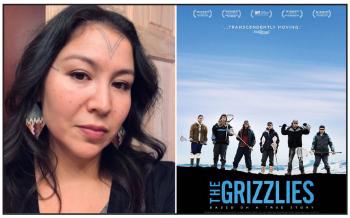Image Caption
Summary
Local Journalism Initiative Reporter
Windspeaker.com
Representatives from the National Lacrosse League (NLL) and the acclaimed movie The Grizzlies converged virtually to provide insight into a number of topics.
Besides discussing various aspects of making the movie, as well as Indigenous rights and player struggles, the virtual event, which was held on Jan. 28, also focused on mental health.
The event was scheduled to coincide with Bell Let’s Talk Day, an annual campaign throughout Canada to raise awareness and combat the stigma of mental illness.
The Grizzlies is based on the true story of a non-Indigenous teacher, Ross Sheppard, who worked to transform the lives of Indigenous youth in Kugluktuk, a hamlet in Nunavut, by introducing them to the sport of lacrosse. Kugluktuk was plagued with high suicide rates, and became more resilient through the young people’s involvement in the sport, giving them them hope for their futures.
“On an interesting and very important day in Canada, which has become Bell Let’s Talk Day, it is important to remember that this game has always been considered a medicine game,” Sheppard said.
The panel included Kyle Aviak, a member of the original Kugluktuk Grizzlies, which was founded in 1999, and Inuit producer Alethea Arnaquq-Baril.
Also taking part were Miranda de Pencier, the director of The Grizzlies, Brodie Merrill, the captain of the NLL’s San Diego Seals, who has a role in the film, and Jessica Berman, the NLL’s deputy commissioner and executive vice-president of business affairs.
Berman said last week’s virtual discussion was an important one.
“The sport of lacrosse and the NLL realize that this sport is rooted in the Indigenous community and it is our duty to take every opportunity that we can to authentically honour the heritage of the game,” she said.
Arnaquq-Baril grew up in Iqaluit, more than 2,000 kilometres from Kugluktuk.
“For me it was such a familiar story, even though I’m from a different Inuit community,” she said. “Our lands are vast and our communities are far apart. But this story was so familiar to me because I also grew up in the same circumstances and also loved sports. For me, it was gymnastics and taekwando that saved me. What made me extra passionate about working on this film is seeing how much the community was involved and empowered through sport.”
In her concluding panel remarks, Arnaquq-Baril stressed the importance of discussing mental health.
“I just want to remind people to normalize talking about mental health in sports. I mean everywhere, but obviously in sports,” she said. “I think it’s historically been tough for athletes to talk about their mental health openly, so let’s normalize talking about our mental health like we do our physical health.”
Arnaquq-Baril said its vital for people to think deeper about some of those performing in sports.
“One of the things I guess I would love for people to take away from the film is to recognize that sometimes people have had to be superheroes even just to make it, so they can step on the field, and for coaches to always remember that about their athletes,” she said.
As for de Pencier, who is from Toronto, she wanted to be a part of The Grizzlies after hearing about the inspiring lacrosse program in the Arctic. Plus, she could relate to certain parts of the film.
“I had suffered depression in high school and sports had really helped me get through,” she said. “I was a runner and a ski racer.”
The Grizzlies inspires because it proves youth can move forward despite struggles and traumas, including a high number of suicides in their community.
Before the movie was filmed, de Pencier recalled a workshop where the youth were discussing losses they had experienced.
“One kid stood up and he said ‘I’ve lost my cousin, my girlfriend, my best friend and the entire front line of my hockey team to suicide’,” de Pencier said, adding that young people felt the movie would provide the beginning of change and a new start.
“I’ve been amazed by my time in the north that a lot of the kids who go through the biggest struggles and the biggest traumas also become the most powerful leaders and are able to say to their friends ‘It’s okay. We’re going to be okay. We can move through this’.”
Arnaquq-Baril said she was also inspired from an eventual scene in the movie when young lacrosse players opt to move forward following a devastating experience.
“Sometimes we get survivor skills when you come from communities that are full of trauma,” she said. “And it can be hard to feel like it’s okay to move on and enjoy life and do what you’re good at and do what you worked hard to be good at.
“Certainly, there have been points in my life where I have my losses of friends and family and felt like I don’t have the right to enjoy my life. So, to see those kids band together and say we earned this, we worked hard for this and we can be sad and grieve people but also move forward with our lives.”
Though he was an original member of the Grizzlies’ team, Aviak’s character in the film was played by someone else.
“There was a great job done of capturing the reality of circumstances that you see in the film,” he said.
Local Journalism Initiative Reporters are supported by a financial contribution made by the Government of Canada.

